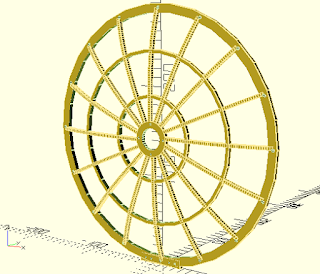So instead, I have tried "trimming" down the metal fan cage, by cutting and removing about half of the spokes. I also 3D printed a new piece to support it more rigidly (the previously used plywood bent too much, and ruined the gear mechanism on the servo motor). The replacement servo motor is expected on Thursday, so I'll know then if the reduced metal cage is light enough.
The Android and PC software was completed for "talking" to the 2nd humidity / temperature sensor inside the battery box and getting its data. I'll do the same for the iOS software after I get the BLE (Bluetooth Low Energy) communications board replaced with the genuine HM-10 model. I also just today added some software for switching the solar panel output voltage on / off to the charge controller. This will avoid the "sometimes" problem (in bright noonday sun) of having too much voltage output from the controller, which causes the electronic speed controller to complain and make beeping noises without turning the propeller.
My brother, Andrew had asked me to consider some ideas for aspects of AMOS that could function as standalone student projects. The ideas that I came up with were (i) a sensor deployment mechanism for deploying one to four sensor probes into water at depths up to 30 m, (ii) a new layout configuration for the surfboard, boxes, and solar panel that reduces everything from a 2.5 m x 0.6 m x 0.6 m form factor to a 1.8 m x 0.6 m x 0.4 m form factor, and (iii) a fiber optic turbidity probe. The fiber optic turbidity probe is not directly related to the core work that is required for AMOS, but could potentially be an interesting product in its own right. Basically it would use two multimode fiber optic cables connected at one end to a single 850 nm LED, and at the other end to two photodiodes. One cable would have a large break in its path (perhaps 20 mm?) that passes through the water being tested, and the other cable would have a much shorter break (perhaps 2 mm?) near the same location as the first, but not close enough that light would interfere from one fiber to the other:
The received light level for the path with the short break should be minimally affected by light scattering due to turbidity, whereas the received light level for the other path should be significantly affected by light scattering due to turbidity. Both paths should experience similar light loss due to LED power fluctuations, temperature effects, fiber bending, and environmental fouling within the sensor chamber. The sensor design has the advantage that a pressure-tight sensor housing is not required, as there are no electrical components within the sensor chamber itself. Hopefully the ratio of the received light levels would follow some sort of repeatable function as the turbidity is varied say between 0 and 3000 NTU.
Another idea that might be kind of cool would be a sort of "production" robot (robots making robots!) that uses a foam hot wire cutter to automatically cut out and shape the foam pieces that form the AMOS surfboard. This would save considerable time, and probably improve the consistency and quality of the final product.




